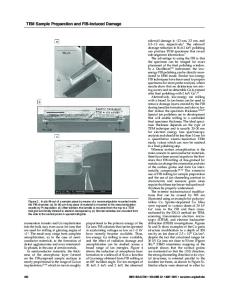Modern Strategies for Environmental Sample Preparation and Analysis
In chemical and geochemical analysis, sample preparation is the most laborious and time-consuming step in the whole analysis. Each sample must be pre-treated prior to the analysis. Even water samples sometimes need pre-treatments to destroy organic matter
- PDF / 4,705,333 Bytes
- 32 Pages / 439.37 x 666.142 pts Page_size
- 48 Downloads / 363 Views
Modern Strategies for Environmental Sample Preparation and Analysis R. E. Santelli· R. J. Cassella· M. A. Z. Arruda· J. A. Nobrega
5.1
Introduction
In chemical and geochemical analysis, sample preparation is the most laborious and time-consuming step in the whole analysis. Each sample must be pre-treated prior to the analysis. Even water samples sometimes need pre-treatments to destroy organic matter or to transform the analyte in an adequate chemical form that is able to be measured. Samples with more complex matrices must be submitted to chemical attacks before analysis. It is worth mentioning that the sample preparation step is one in the chemical analysis where more errors are involved and it is directly enclosed with total costs. Even considering that microwave-assisted procedures have had a major impact on the preparation of samples containing higher amount of organic materials, successful procedures for inorganic-based materials can be found in the literature (Kingston and Haswell 1997). Owing to the high complexity of geological materials, the preparation of representative solutions using acid digestion is not straightforward. Even considering all the advances in microwave-assisted procedures (Kingston and Haswell 1997; Smith and Arsenault 1996), there is only a marginal impact of this relatively new technology for sample preparation in geochemical analysis. This can be explained considering that geological samples frequently contain refractory materials such as spinels and aluminosilicates that are not easily decomposed. Poor sample throughput unsuitable for large-scale geochemical surveys is also a factor. Concerning sample pre-treatment, the aim of this chapter is to mention the modern strategies to turn environmental samples adequate to performing chemical or physical-chemical measurements. Also, modern methods that determine environmental species will be discussed. Ideally, a sample preparation step could present some characteristics such as simplicity, speed, use of small reagent volumes, application to different samples and capability for accurate and precise results. In the classical literature, several pre-treatment methods can be found dealing with environmental samples. However, modern technologies such as microwave energy, ultrasound radiation, solid-phase extraction and micro extraction, supercritical fluid extraction coupled to the use of new reagents and experimental conditions have been successfully employed to perform fast, efficient and clean sample preparation. Also, today, laboratories must drive their activities to the green chemistry, generating fewer residues for good chemistry.
L. D. de Lacerda et al. (eds.), Environmental Geochemistry in Tropical and Subtropical Environments © Springer-Verlag Berlin Heidelberg 2004
R. E. Santelli· R. J. Cassella· M. A. Z. Arruda· J. A. Nobrega
5.2
Microwave-Assisted Sample Preparation
Analytical chemists and geochemists usually employ in their laboratories convective systems that promote heating of solutions for sample preparation purposes.
Data Loading...











